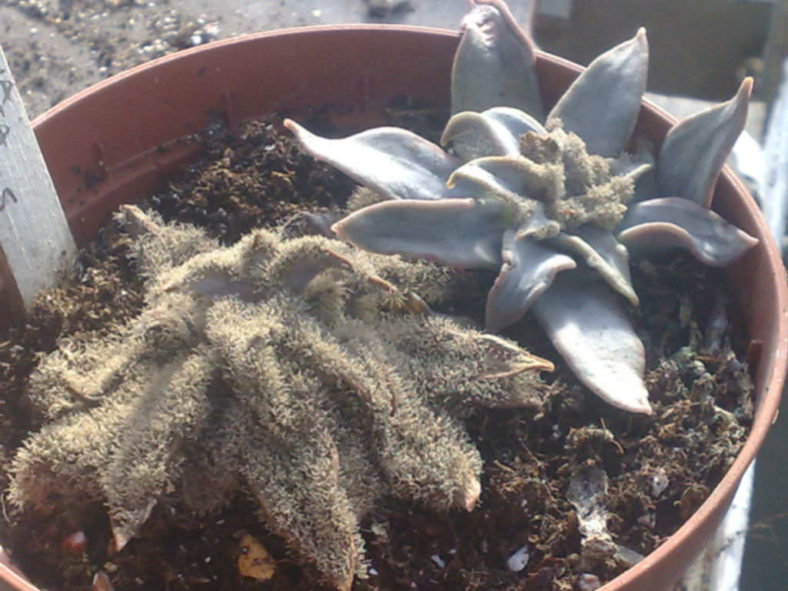Succulents are easier to grow than most, but like all plants, they also have their share of problems. Although they come in a wide range of sizes, shapes, and colors, succulents all share a propensity to develop fungal infections when out of their naturally dry habitats. Surface fungi are easy to treat when present in succulents, but the various types of fungi that cause internal rots can pose much more complex problems. Some fungal infections are difficult to treat.
Sooty Mold
Sooty Mold, also called Black Mold, is among the least damaging fungi on succulents. It appears that the Sooty Mold feeds on the sweet substance exuded by aphids, mealybugs, whiteflies, and scale, as these insects excrete a substance called honeydew. To eliminate Sooty Mold, insect infestation must be eliminated. First, spraying the plant with a hose removes the honeydew, and then an appropriate insect control method is implemented. Fortunately, Sooty Mold does not cause direct damage to succulents, although it can interfere with photosynthesis if large colonies are present.
Grey Mold
Botrytis cinerea, commonly known as Gray Mold, is easily identified by its grayish-brown spore masses on the surfaces of affected succulent leaves and flowers. Gray Mold is most common when the weather is cool and wet in early spring or summer. It establishes itself in older, damaged, or dying plant tissues and quickly spreads outward. Where Gray Mold is prevalent, fungicides can be used as a preventive measure, but they will not cure an infestation. Affected areas of the succulent need to be cut out and burned to remove damaged tissues. Watering succulents from the top is best avoided, allowing them to dry between watering and not leaving stubs when taking cuttings.

Leaf Spots
Succulents have demonstrated a wide tolerance to the fungi that cause leaf and stem spots. These fungi are mostly harmless, although they can cause severe disfigurement to landscape plants. Shallow tan lesions appear on susceptible plants, creating permanent stippling or spotting. In the landscape, replacing the plant with a more resistant cultivar may be warranted, or spots can be tolerated, as they do very little damage despite their appearance. Heavily infested succulents may spread spots to other plants; however, fungicide is generally not recommended.
Anthracnose
Fungi in the genus Colletotrichum cause anthracnose and affect a wide range of succulents. Anthracnose often appears as a moist tan-colored rot with red, orange, or pink bumps on the surface. Spots start small but expand rapidly on both leaves and crowns. Once a succulent is infected, the only treatment is the removal and destruction of affected leaves. Anthracnose can be spread through contaminated pots or soils, so tools and pots require thorough disinfecting, and garden soil is not reusable. The application of copper fungicide may help to destroy fungal bodies.
Fusarium Wilt
The pathogen that causes Fusarium Wilt is Fusarium oxysporum. Fusarium Wilt interferes with a succulent's ability to take up water, causing heavy stress, wilting, yellowing, and sometimes death. This soil-borne fungus, which is incurable, enters the plant through its roots and begins reproducing in the vascular tissues. Eventually, these tissues become blocked, making it difficult or impossible for succulents to transport water. If tissues are cut open, brown streaks are observed. Practicing good sanitation when working with potted plants helps prevent the spread of Fusarium Wilt. Affected landscape plants are fed and watered properly to help them survive until they can grow new, unaffected tissues. Watering is continued sparingly to discourage future fungal growth.
Root and Crown Rots
The fungal pathogens of the genus Phytophthora cause various root and crown rots. Unfortunately, these diseases are difficult to differentiate from the early stages of other fungal diseases, as their symptoms are largely nonspecific. Affected plants become stressed, wilt, change colors, and eventually die from a slow rot that develops upward from the soil level. Although root and crown rots do not respond well to treatment, they can be discouraged by planting succulents in well-draining soils and being careful not to overwater.
Source: sfgate.com
Links
- Succupedia: Browse succulents by Scientific Name, Common Name, Genus, Family, USDA Hardiness Zone, Origin, or cacti by Genus